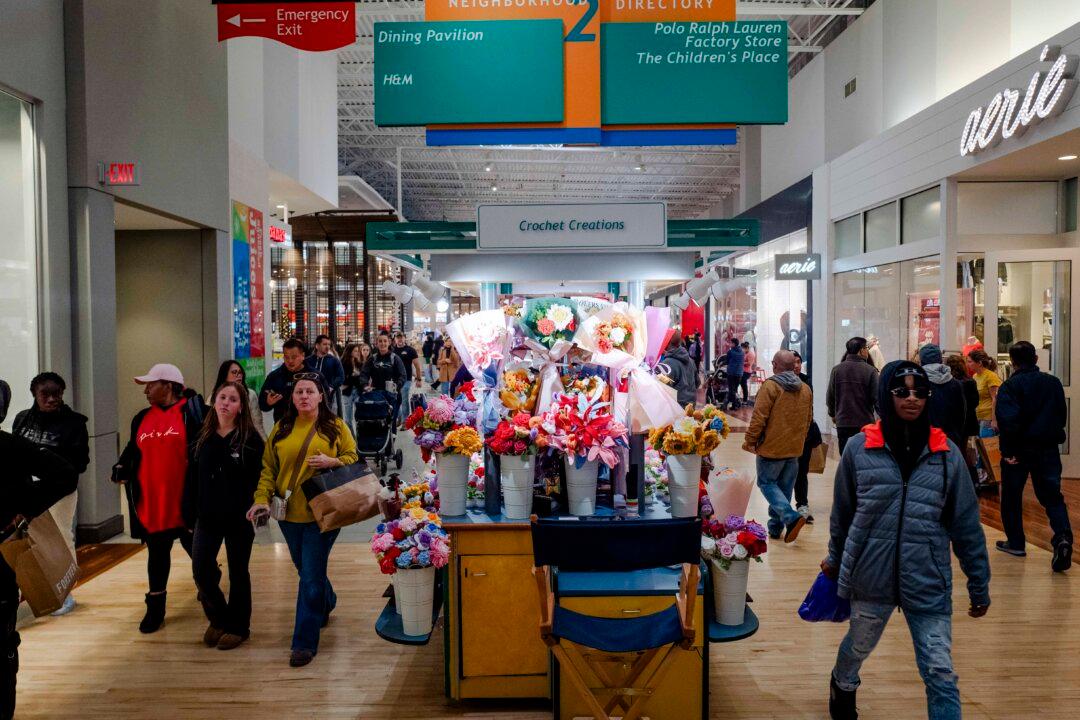A record number of shoppers—online and in person—are expected over the Thanksgiving holiday weekend, officially marking the start of the 2024 Christmas shopping season.
This estimate is up from the previous record of 182 million in 2023.
Kiarra is one of the many people visiting the Arundel Mills shopping center in Hanover, Md., to take advantage of the discounts, telling The Epoch Times that this is an annual tradition for her.
“I’m trying to get an early start on Christmas shopping while they have the deals,” said Kiarra, who did not reveal her last name. “This is the first year I got smart enough to bring my cart, so I don’t have to carry all the bags, and I can get as much stuff as I like.”
Prices are a bit higher because of inflation, Kiarra says, but the sales can help reduce the dent in her pocketbook.
She said Old Navy and North Face were some of the many stores offering steep discounts.
While more companies and digital platforms are starting their holiday campaigns weeks before Thanksgiving, the five-day shopping sprint remains the busiest time for retailers and companies, says Katherine Cullen, the vice president of NRF’s Industry and Consumer Insights.
“Consumers are prioritizing gift-giving for the most important people in their lives, and retailers are prepared to help customers find everything on their shopping lists at great prices throughout the season,” Cullen said.
With U.S. labor remaining intact and solid nominal (non-inflation-adjusted) wage growth, the organization anticipates another season of steady sales growth.
Consumers’ total holiday spending could be as much as $989 billion in November and December, up from $955.6 billion during the same span in 2023
“The economy remains fundamentally healthy and continues to maintain its momentum heading into the final months of the year,” Matthew Shay, NRF’s president and CEO, said in the report.
“The winter holidays are an important tradition to American families, and their capacity to spend will continue to be supported by a strong job market and wage growth.”

Heading into the annual festivities, consumer spending has been solid.
This accounted for much of the GDP expansion in the July–September period.
Online commerce will account for a sizable share of shoppers’ spending sprees this year, which could help diminish the vast crowds at nearby malls and prevent the chaos observed in previous seasons.
The five-day cyber shopping period is expected to account for nearly a fifth of the Christmas season, exceeding $40 billion.
This, too, is up by 7 percent from last year.
Consumers will also complete more of their purchases on mobile devices, hitting a new milestone of $128.1 billion, an increase of nearly 13 percent from a year ago.
According to Vivek Pandya, lead analyst at Adobe Digital Insights, discounts are the driving force behind this growth.
“The holiday shopping season has been reshaped in recent years, where consumers are making purchases earlier, driven by a stream of discounts that has allowed shoppers to manage their budgets in different ways,” Pandya stated.
“These discounting patterns are driving material changes in shopping behavior, with certain consumers now trading up to goods that were previously higher-priced and propelling growth for U.S. retailers.”

Though price pressures have stabilized compared to the past few years, consumers believe inflation will affect their Christmas shopping plans, according to data from Experian’s latest annual holiday shopping survey.
The report’s findings, shared with The Epoch Times, highlighted that 68 percent of shoppers say inflation will affect their spending, with 63 percent saying they already spend too much during Christmas.
Bureau of Labor Statistics calculations show that Americans’ purchasing power has tumbled by 3 percent from last year.
“This is a return to the pre-pandemic norm when these goods consistently experienced outright declines in prices,” the report stated.
“The outsized inflation for the holiday shopping basket in 2021 and 2022—driven by bottlenecks in global manufacturing and transportation—was the exception. The renewed moderation in prices should incentivize consumers to purchase more goods.”.
But while consumers will hit the malls and peruse their digital platforms, many also expect to take on debt to cover their purchases.
Additionally, more than one-quarter (28 percent) are worried about taking on debt from their Christmas shopping.
Meanwhile, some shoppers are still paying off their debt from last year’s gift-giving.
The survey also found that 10 percent think they will tap into their emergency savings to buy Christmas gifts, and 9 percent will prioritize gift buying before paying their regular bills.
“While celebrating the season is a top priority for many Americans, going overboard can cause stress for months afterward, so it’s worth planning ahead to reduce costs where possible,” Kimberly Palmer, personal finance expert at NerdWallet, said in the report.
Still, the most wonderful time of the year will again contribute a hefty sum to the national GDP, since U.S. economic growth is driven by two-thirds of consumption.








